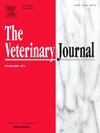牛奶的1H-NMR代谢组学和免疫细胞特征可能揭示亚临床乳腺炎和四分之一相互依赖的见解。
IF 3.1
2区 农林科学
Q1 VETERINARY SCIENCES
引用次数: 0
摘要
乳代谢组取决于多种因素和不同细胞类型的存在,可以帮助理解乳腺的生物学,并可能识别乳腺炎、组织修复和乳质量的生物标志物。为了实现这些期望,代谢组变化需要在几种特征良好的生理和病理生理条件下进行准确的表征。本研究的目的是研究受亚临床乳腺炎(SCM)和急性炎症影响的奶牛的乳腺区与健康动物的比较。通过1H-NMR光谱和流式细胞术评估体细胞群,利用白细胞标记物(CD11b, CD44, CD14, CD4, CD8, CD21)研究牛奶代谢组。采用微生物学评价和氧化蛋白(AOPP)测定相结合的方法对研究结果进行多元模型分析。CD11b阳性细胞最高的乳腺区,提示急性炎症,仅存在于受scm影响的奶牛中,并且具有显著较高的AOPP,其中微生物分析显示存在少量病原体。在健康和感染SCC的动物之间观察到良好的PCA分离(总错误率:0.177±0.056),证实SCC与乳代谢组的改变有关。以健康奶牛和患scm的奶牛的节节中CD11b阳性细胞的比例进行分类时,分类准确率较低,总错误率为0.343±0.029。有趣的是,低cd11b - scm样本容易被错误分类(错误率:0.460),这表明受感染邻近小区的影响。这项工作的结果强调了研究受SCM影响的动物乳房区域功能相互依赖的重要性。摘要:本研究探讨了亚临床乳腺炎——奶牛的一种轻微的、经常隐藏的乳房感染——如何影响牛奶中的代谢物。采用核磁共振波谱法比较了健康奶牛与由细菌感染引起的亚临床乳腺炎奶牛的产奶量。我们发现受感染奶牛的代谢谱(代谢组)发生了显著变化。这些变化与免疫细胞活性和可能对乳房组织造成的损害有关。令人惊讶的是,在被感染的奶牛中,即使是看似健康的部分乳房有时也会显示出牛奶成分的变化。这表明,乳房某一部分的感染会影响到附近的部分,或者导致奶牛免疫和代谢系统发生更广泛的变化。这一发现支持了牛奶代谢物可用于检测乳腺感染早期阶段的建议。该研究还强调了乳房的不同部分是如何连接的,以及当奶牛患乳腺炎时,即使是“健康”的部分也会受到影响。本文章由计算机程序翻译,如有差异,请以英文原文为准。
1H NMR metabonomics and immune cell signature of milk may reveal insights into subclinical mastitis and quarter interdependence
Milk metabolome depends on a plethora of factors and on the presence of different cell types and could help understanding the biology of the mammary gland and, possibly, identifying biomarkers for mastitis, tissue repairing and milk quality. To fulfill these expectations, metabolome changes need an accurate characterization under several well-characterized physiological and pathophysiological conditions. The aim of the present work is to study mammary quarters of dairy cows affected by subclinical mastitis (SCM) and acute inflammation compared to healthy animals. The milk metabolome was investigated by 1H NMR spectroscopy and by the assessment of somatic cell populations by flow cytometry using a panel of leukocyte markers (CD11b, CD44, CD14, CD4, CD8, CD21). The study was integrated by microbiological evaluations and oxidized proteins (AOPP) determination and results were analyzed by multivariate model. Mammary quarters with the highest CD11b positive cells, suggestive of acute inflammation, were present in SCM-affected cows only, and were characterized by significantly higher AOPP, where the microbiological analysis revealed the presence of minor pathogens. A good PCA separation between healthy and SCM-infected animals was observed (overall error rate: 0.177 ± 0.056) confirming that SCC are associated with modifications of milk metabolome. The classification accuracy was lower (overall error rate: 0.343 ± 0.029) when the mammary quarters were classified on the fraction of CD11b positive cells of quarters from healthy and SCM-affected cows. Interestingly, low-CD11b-SCM samples tended to be misclassified (error rate: 0.460), suggesting the influence of infected neighboring quarters. The results of this work underlay the importance of studying the functional interdependence of mammary quarters in animals affected by SCM.
Simple summary
This study explored how subclinical mastitis—a mild, often hidden udder infection in dairy cows—affects the metabolites in milk. Nuclear magnetic resonance spectroscopy was used for comparing milk from healthy cows to that produced by cows with subclinical mastitis caused by bacterial infections. We found that the metabolic profile (metabolome) of analyzed milk changed noticeably in infected cows. These changes were linked to both immune cell activity and possible damage to udder tissue. Surprisingly, even parts of the udder that seemed healthy in infected cows sometimes showed altered milk composition. This suggests that infections in one part of the udder can influence nearby quarters or cause broader changes in the cow’s immune and metabolic systems. The findings support the suggestion that milk metabolites could be used to detect early stages of udder infections. The study also highlights how different quarters of the udder are connected, and how even the “healthy” ones can be affected when a cow suffers from mastitis.
求助全文
通过发布文献求助,成功后即可免费获取论文全文。
去求助
来源期刊

Veterinary journal
农林科学-兽医学
CiteScore
4.10
自引率
4.50%
发文量
79
审稿时长
40 days
期刊介绍:
The Veterinary Journal (established 1875) publishes worldwide contributions on all aspects of veterinary science and its related subjects. It provides regular book reviews and a short communications section. The journal regularly commissions topical reviews and commentaries on features of major importance. Research areas include infectious diseases, applied biochemistry, parasitology, endocrinology, microbiology, immunology, pathology, pharmacology, physiology, molecular biology, immunogenetics, surgery, ophthalmology, dermatology and oncology.
 求助内容:
求助内容: 应助结果提醒方式:
应助结果提醒方式:


